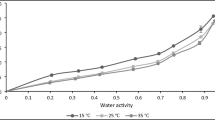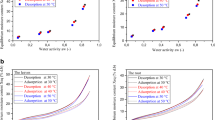Abstract
The sorption isotherms of Oolong tea were determined at temperatures ranging from 5 to 50 °C. Estimated parameters and fitting ability for nine equilibrium relative humidity (ERH) models were evaluated. The modified Oswin equations were found to be an adequate model of three parameters to describe the sorption data. The Andrieu model was the only adequate model of four parameters. In comparing the results of this study with previously published data, it was found that the sorption properties were affected by species and manufacture techniques. The Guggenheim–Anderson–de Boer (GAB) model was not an adequate model as indicated by checking residual plots. The monolayer moisture content calculated from the Brunauer–Emmett–Teller (BET) model was lesser than that calculated from the GAB model. The errors of moisture content determined by measuring the ERH and temperature of samples was within 0.35%.
Access this article
We’re sorry, something doesn't seem to be working properly.
Please try refreshing the page. If that doesn't work, please contact support so we can address the problem.






Similar content being viewed by others
Abbreviations
- A, B, C, D:
-
constants
- C o :
-
constants
- MRPD:
-
mean relative percentage deviation
- df :
-
degree of freedom of regression model
- e :
-
standard error of the estimated value
- RH:
-
equilibrium relative humidity in decimal
- M :
-
moisture content by dry basis, %
- M o :
-
monolayer moisture content, %
- N :
-
number of data points
- R 2 :
-
coefficient of determination
- T :
-
temperature, °C
- Y :
-
measured value by the model
- Y′:
-
predicted value by the model
- q n s :
-
net heat of sorption isosteric, kJ/kg
References
Andrieu, J., Stamatopoulos, A., & Zafiropoulos, M. (1985). Equation for fitting desorption isotherms o durum wheat paste. Journal of Food Technology, 20, 651–657.
Arslan, N., & Togrul, H. (2005). Moisture sorption isotherms for crushed chillies. Biosystems Engineering, 90(1), 47–61.
Arslan, N., & Togrul, H. (2006). The fitting of various models to water sorption isotherms of tea stored in a chamber under controlled temperature and humidity. Journal of Stored Products Research, 42, 112–135.
ASAE (1996). Moisture relationships of plants-based agricultural products. ASAE Standards D245.5 OCT95. Agricultural engineering yearbook (pp. 452–464, 43th ed.). St. Joseph, MI: ASAE.
Bellagha, S., Sahil, A., & Farhat, A. (2007). Desorption isotherms and isosteric heat of three Tunisian date cultivars. Food and Bioprocess Technology, DOI 10.1007/s11947-007-0006-1.
Boquet, R., Chirife, J., & Iglesias, H. A. (1978). Equations for fitting water sorption isotherms of foods. II. Evaluation of various two-parameter models. Journal of Food Technology, 13, 319–327.
Chen, C. (2000). Factors which effect equilibrium relative humidity of agricultural products. Transactions of the ASAE, 43(3), 673–683.
Chen, C. (2001). Moisture measurement of grain using humidity sensors. Transactions of the ASAE, 44(5), 1241–1245.
Chen, C. (2002). Sorption isotherms of sweet potato slices. Biosystems Engineering, 83(1), 85–95.
Chen, C. S., & Clayton, J. T. (1971). The effect of temperature on sorption isotherms of biological materials. Transactions of the ASAE, 14(5), 927–929.
Chen, C., & Jayas, D. S. (1998). Evaluation of the GAB equation for the isotherms of agricultural products. Transactions of the ASAE, 41(6), 1755–1760.
Chen, C., & Morey, R. V. (1989a). Comparison of four EMC/ERH equations. Transactions of the ASAE, 32(3), 983–990.
Chen, C., & Morey, R. V. (1989b). Equilibrium relative humidity (ERH) relationships for yellow-dent corn. Transactions of the ASAE, 32(3), 999–1006.
Cordeiro, D. S., Raghavan, G. S. V., & Oliveira, W. P. (2006). Equilibrium moisture content models for Maytenus ilicifolia leaves. Biosystems Engineering, 94(2), 221–228.
Day, D. L., & Nelson, G. L. (1969). Desorption isotherms for wheat. Transactions of the ASAE, 8, 293–297.
Ghodake, H. M., Goswami, T. K., & Chakraverty, A. (2007). Moisture sorption isotherms, heat of sorption and vaporization of withered leaves, black and green tea. Journal of Food Engineering, 78, 827–835.
Kaleemullah, S., & Kailappan, R. (2004). Moisture sorption isotherms of red chillies. Biosystems Engineering, 88(1), 95–104.
Kumar, A., Herum, F. L., & Blaisdell, J. L. (1978). Equilibrium moisture contents of intact corn ears and component parts. ASAE Paper No. 78-3054. St Joseph, MI: ASAE.
Labuza, T. P., Tannenbaum, S. R., & Karel, M. (1970). Water content and stability of low-moisture and intermediate-moisture foods. Food Technology, 24, 543–549.
Lewicki, P. P., & Pomaranska-Lazuka, W. (2003). Errors in static desiccator method of water sorption isotherms estimation. International Journal of Food Properties, 6(3), 557–563.
Myers, R. H. (1986). Classical and modern regression with application. Boston, USA: Duxbury.
Panchariya, P. C., Popovic, D., & Sharma, A. L. (2001). Modeling of desorption isotherm of black tea. Drying Technology, 19(6), 1177–1188.
Quirijns, E. J., van Boxtel, A. J., van Loon, W. K. P., & van Straten, G. (2005). Sorption isotherms, GAB parameters and isosteric heat of sorption. Journal of the Science of Food and Agriculture, 85, 1805–1814.
Shen, Y., & Chen, C. (2007). Preparation of reference materials for rice kernels. Biosystems Engineering, 97(1), 41–49.
Soysal, Y., & Oztekin, S. (2001). Comparison of seven equilibrium moisture content equations for some medicinal and aromatic plants. Journal of Agricultural Engineering Research, 78, 57–63.
Temple, S. J., & van Boxtel, A. J. B. (1999). Equilibrium moisture content of tea. Journal of Agricultural Engineering Research, 74, 83–89.
Timmermann, E. O., Chirife, C., & Iglesias, H. A. (2001). Water sorption isotherms of foods and foodstuffs: BET or GAB parameters? Journal of Food Engineering, 48, 19–31.
Wolf, W., Speiss, W., & Jung, G. (1973). Water vapour sorption isotherms of some foods. Lebensmittel-Wissenschaft und -Technologie, 6(3), 94–96.
Zanoelo, E. F. (2005). Equilibrium moisture isotherms for Mate leaves. Biosystems Engineering, 92(4), 445–452.
Author information
Authors and Affiliations
Corresponding author
Rights and permissions
About this article
Cite this article
Chen, C., Weng, YK. Moisture Sorption Isotherms of Oolong Tea. Food Bioprocess Technol 3, 226–233 (2010). https://doi.org/10.1007/s11947-008-0075-9
Received:
Accepted:
Published:
Issue Date:
DOI: https://doi.org/10.1007/s11947-008-0075-9




